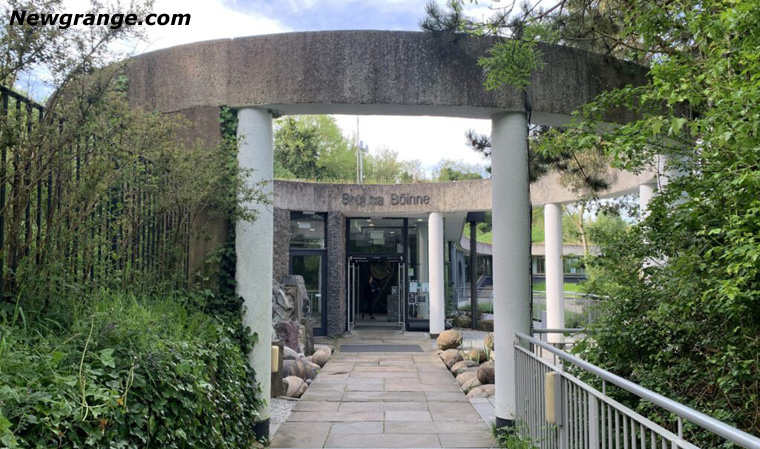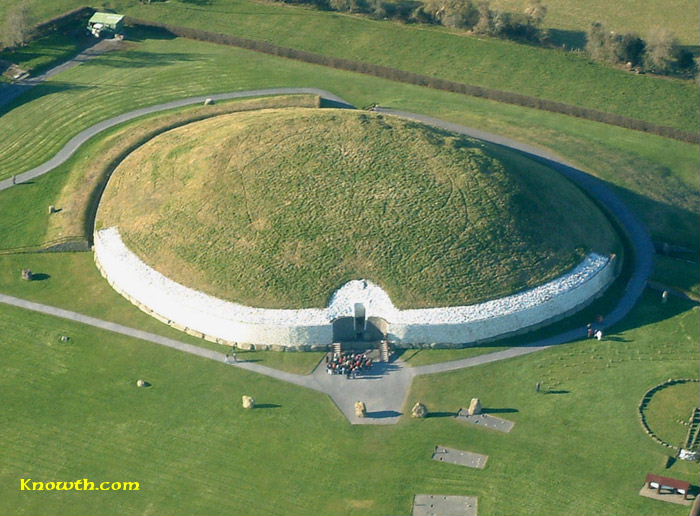Spirals within Spirals, Stones have Stories to Tell
A personal essay by James Nemec (1953-2011) - Page 9When we got back to the eye-catching Visitor Centre, I looked at the explanations and photographs on the walls and wanted to share my major discovery. I couldn't restrain myself, nor could I articulate what I was feeling in words.
What if maybe one day those at the Brú na Bóinne Visitor Centre would set up very special, limited tours for others to either energetically attune with or touch the stones? This way, others could find out if this was true or false for themselves.
"Do you think the people who work here get it?" I whispered to Eileen.
"Do you think they know?"
"Let's go," said Eileen.
"Do you think they know?"
"Let's go," said Eileen.
I went up to the information booth. There were two warm, young Irish women there. My face was flushed with excitement. I was about to speak, then I felt a curous disconnect, for I suddenly felt like a character in a new play that I would write. Had I felt this way all along? I gave myself another second to contemplate whether James Joyce had ever felt himself to be the character of Leopold Bloom in his Ulysses, no matter, then I announced to them, "Do you know what happens when you touch the stones?" One of them smiled an official Brú na Bóinne smile to me. She pointed. "The parking lot is that way, sir." I backed away. "But the stone with the two semi-circles, you have to sit on that one. Do it and you will see what it's about!" Both the women looked to Eileen, who apologized for me. "He's had a long day," said Eileen. Then I realized. "Sorry," I said. "You must have a million people a day telling you about these stones and what they really mean." The one that had smiled said, "Yes, we do." My friend put her hand inside my elbow and encouraged me to the parking lot. I turned back to them again, "Remember to touch the stones! Especially that one kerbstone, it's an engagement stone! Sit with it. It will give you good luck!" They looked at me, a blank.
"Seamus?" said Eileen, entreating. Seamus is the name Eileen would use for me when she meant business. But I couldn't help myself. "Knowth is so totally different from Newgrange!" I yelled back. "It really rocks." They smiled, waved me away. Eileen smiled again. "Bad pun," she offered. I appreciated her attitude. There are some things our friends do that endear us to them. This was my time to be made adorable by my friend. But what surprised me was this: I didn't feel like a nut. There had to be others who knew about this, if not Joyce himself, there simply had to be others who knew about this place, not with their minds only, but with their hearts and bodies and hands. Was the focused application a very light touch a World Heritage Site's best kept secret?
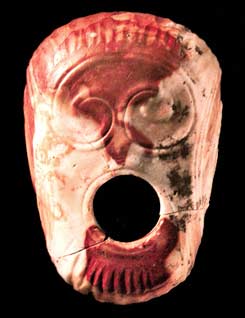 "We
went back for a sip of water from the fountain and walked by a wall
photograph of the mask from the small display room in Knowth.
"Oh, there's that mask," I said.
"Mask?" said my friend, "It's a macehead!"
"A macehead? What in the world is a 'macehead'?"
"We
went back for a sip of water from the fountain and walked by a wall
photograph of the mask from the small display room in Knowth.
"Oh, there's that mask," I said.
"Mask?" said my friend, "It's a macehead!"
"A macehead? What in the world is a 'macehead'?"
Back in the small display room, our tour guide had pointed out a smaller, wall photograph of a macehead. She said it was a rare and beautiful example of Neolithic stone carving. She said it had perhaps been used as a weapon, or set up on a tall wooden pole. But she wasn't sure if there had ever been an indication that wood or stone had been found within its aperture. It remains very precious and the original macehead itself is at the National Museum in Dublin.
But I didn't realize our tour guide had said "mace." Because of her accent, I thought she'd said "mask." Then I'd thought she'd said only "head." Mainly, I was paying attention to the passageways and chambers at the time. Why would they put a mask on a wooden pole? I wondered. To me, it was a mask. It was to be placed in the hands and put near the face. For a moment, I wished I could hold the original in my own hands. I wanted to place it near my mouth and say the universal sounds of, "Ah" and "Om." I had wished we all could put that wonderful mask on our faces that day. Aside from looking like the painting, The Scream, by Edvard Munch, at first impression, it was something to hold, and something to make sounds from. No, not the sounds of screams. It was something to respect. It wasn't a mace but a mouthpiece, for me, and much later I would imagine it to be a mouthpiece to the Cosmos. Who would work so hard on an object like that to use as a weapon? Even as a sacrificial weapon. It didn't make sense. No, this was something special, more than a weapon. The spirals curled over the eyes, and by extension, to the mouth and over the sides. The spirals were in the shapes of sound, or even of light. Long after my visit to Knowth, and what happened to me there, I would consider this a microphone back to Headquarters. What do I mean by Headquarters? I don't know. Call it, Canopus in Argos.
Anything seemed possible now.
In the parking lot, I began to recall the words of Yeats. Turning and turning in a widening gyre/The falcon cannot hear the falconer/Things fall apart; the center cannot hold/Mere anarchy is loosed upon the world. A gyer, I thought, that's a spiral isn't it? Eileen started her Alfa Romeo. At least, there were swirling gyres in the ocean. After we passed the magnificent view of the Newgrange mound high on the hill, I recited the Yeats poem to Eileen,
The Second Coming by William Butler Yeats
Turning and turning in the widening gyreThe falcon cannot hear the falconer;
Things fall apart; the centre cannot hold;
Mere anarchy is loosed upon the world,
The blood-dimmed tide is loosed, and everywhere
The ceremony of innocence is drowned;
The best lack all conviction, while the worst
Are full of passionate intensity.
Surely some revelation is at hand;
Surely the Second Coming is at hand.
The Second Coming! Hardly are those words out
When a vast image out of Spiritus Mundi
Troubles my sight: somewhere in sands of the desert
A shape with lion body and the head of a man,
A gaze blank and pitiless as the sun,
Is moving its slow thighs, while all about it
Reel shadows of the indignant desert birds.
The darkness drops again; but now I know
That twenty centuries of stony sleep
Were vexed to nightmare by a rocking cradle,
And what rough beast, its hour come round at last,
Slouches towards Bethlehem to be born?
"Cheerful," she said. She put her focus on the road. She mentioned she would take me back, but we never got the chance before our work would begin in the West. Anyway, it was a lot.
After we returned to Dublin and had a pleasant dinner together with hot Irish tea, I couldn't sleep. I got up from my bed, went down the stairs in Eileen's home, and wrote my experiences down, best I could. Again, what could I learn? What was my purpose? I remembered a friend from Northern California, an old man with snowy white hair named Rhondell, or "Dr. Bob," once suggested that after an experience, if we remember to ask this simple question, "What can I learn?" it spiritualizes the whole event. These have only been an American writer's rambling notes in the wee hours of an Irish night.
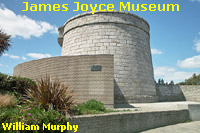 It
so happened that we did go to the
James Joyce Museum.
We took the commuter train there from Dublin to Sandycove some days later. I had
to know if James Joyce had visited Newgrange or
Knowth before writing Ulysses,
but could find nothing of this on the Internet. And even if there was anything
on the Internet about it, I didn't want to know, for I wanted to walk to the
Tower for myself and discover the feeling in my own body. We left the train
station and decided to wander instead of hire a Taxi. Dublin Bay was bright and
blue, and as we walked the seaside path, it began to feel like a pilgrimage for
both of us. For Eileen, because this was part of her Irish National Heritage,
and for me because, well, I can make almost anything into a pilgrimage with my
active imagination!
It
so happened that we did go to the
James Joyce Museum.
We took the commuter train there from Dublin to Sandycove some days later. I had
to know if James Joyce had visited Newgrange or
Knowth before writing Ulysses,
but could find nothing of this on the Internet. And even if there was anything
on the Internet about it, I didn't want to know, for I wanted to walk to the
Tower for myself and discover the feeling in my own body. We left the train
station and decided to wander instead of hire a Taxi. Dublin Bay was bright and
blue, and as we walked the seaside path, it began to feel like a pilgrimage for
both of us. For Eileen, because this was part of her Irish National Heritage,
and for me because, well, I can make almost anything into a pilgrimage with my
active imagination!
Did stones have stories to tell?
Visioning isn't an exercise accomplished through the soul nor through the spirit, but through the prismatic mind. The space which is between the two. Our job is to simply be aware. Young men were diving from the rocks into the chill waters of the Bay as we approached the Tower. I recalled the swim of "Stately, plump Buck Mulligan" from the opening pages of Ulysses. Their faces and bodies were reddened with the temperature, although it was windy and hot. I was surprised that the Tower was a lovely museum. I'd thought it would just be an old, abandoned tower. I held the glass door open for my friend, slipped inside, and felt the change in temperature from the air conditioning. I was in an entirely different place now. There was a death mask of James Joyce in plaster-cast on the wall to my left. I slowly approached it, then looked down at the books in the glass cases. I was at the Dublin Writers' Museum again, for here I saw the opening lines of Ulysses, lines that mentioned this very tower. I read the pages, wondering where the entrance to the spiralling staircase was, and looked behind. I had to know. Then there was a well mannered man behind the visitors' desk. He appeared quite educated and was dressed in a fine gray suit. I had the tin whistle inside my coat pocket, fingered it for courage, and took off my new Irish Rover hat. I didn't know how I would say to him what I had to say. I think I started with,
"Um, ever heard of Knowth?"
"Knowth?"
"I'm just wondering if there is a connection or something."
"A connection? I'm afraid I don't understand."
"Knowth?"
"I'm just wondering if there is a connection or something."
"A connection? I'm afraid I don't understand."
Eileen had wandered off to the other rooms of the museum and was already approaching the Tower itself. I tried to describe what had happened to me at Knowth and the spiraling structure of Ulysses, then I stopped. He was looking at me as if I were someone from outer space.
"A connection?" he said again.
"Yes."
"Yes."
He became thoughtful. He said Knowth was only uncovered recently. He mentioned the 1940s and then the 1960s. He wouldn't think that James Joyce would have visited there because in Joyce's time, it was privately-held farmland.
"Well, did Joyce know the farmers?"
"I would think not. Besides, it was unexcavated then."
I could feel my enthusiasm drop. I looked to the museum. "I guess the Tower is over that way?"
"I would think not. Besides, it was unexcavated then."
I could feel my enthusiasm drop. I looked to the museum. "I guess the Tower is over that way?"
He seemed to feel for me. Then a light went off in his eyes. "One moment," said, "Wait here." He picked up his keys and went to the other room. I could hear him opening a case with the keys. My shoulders had slumped to the visitors' desk by the time he returned. I still wanted to see the Tower. I needed to know if the staircase wound up and then down again. I wanted to feel it my body. I didn't see that he had presented a book of scholarly commentary to me on Finnegan's Wake. He seemed happy about it. The book was erudite but had a simple yellow jacket. Below the title of the book in outline fashion were three connecting spirals, an example of the same megalithic art.
"Finnegan's Wake?" I questioned.
"Yes, it's here," he said. "The connection you're looking for? Here on the cover."
I smiled. It was a start.
"Yes, it's here," he said. "The connection you're looking for? Here on the cover."
I smiled. It was a start.
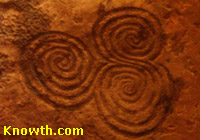 For
me, Finnegan's Wake, published after Ulysses, was never about the words,
words which are mere symbols, but about the feeling behind the words, and the
feeling of the rhythms, circles, intersecting spirals, the white part of the
pages, the spaces, even the locations in which the book is held in the hands by
the reader. I felt better. Now, as I walked to the Tower, I remembered something
else I'd read at the Newgrange museum about the megalithic carvings of the
stones. It was something about hidden art. What was this "hidden art?" It was
art that was carved on the reverse side of many of the great kerbstones around
the mound, and hidden from view. Why hidden? After thousands of theories,
jillions of ideas, the jockeying to be right at any price in our fast-food age,
it was possible that the ancient builders actually intended the deeper meaning
of the art to be hidden.
For
me, Finnegan's Wake, published after Ulysses, was never about the words,
words which are mere symbols, but about the feeling behind the words, and the
feeling of the rhythms, circles, intersecting spirals, the white part of the
pages, the spaces, even the locations in which the book is held in the hands by
the reader. I felt better. Now, as I walked to the Tower, I remembered something
else I'd read at the Newgrange museum about the megalithic carvings of the
stones. It was something about hidden art. What was this "hidden art?" It was
art that was carved on the reverse side of many of the great kerbstones around
the mound, and hidden from view. Why hidden? After thousands of theories,
jillions of ideas, the jockeying to be right at any price in our fast-food age,
it was possible that the ancient builders actually intended the deeper meaning
of the art to be hidden.The body knows.
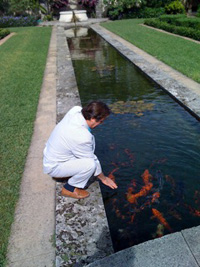 When
I would walk up the spiralling staircase of the tower, looking
for my friend, Eileen, I could not avoid touching a stone here and
there to keep my balance on the winding way up. I did not know that
the stones would feel different here than at Knowth. They would be
cool to the touch, and the feeling that would come back into my hands,
different again. Neutral. By the same token, after my return to the United
States, I would visit a cathedral one Sunday near the ocean with another friend,
a refined woman from France who is herself a practitioner in light touch therapy. We would notice
how the layout of a cathedral design, with its vaulted ceilings and
light, is very much like a symbol of the human body and of the Church.
When
I would walk up the spiralling staircase of the tower, looking
for my friend, Eileen, I could not avoid touching a stone here and
there to keep my balance on the winding way up. I did not know that
the stones would feel different here than at Knowth. They would be
cool to the touch, and the feeling that would come back into my hands,
different again. Neutral. By the same token, after my return to the United
States, I would visit a cathedral one Sunday near the ocean with another friend,
a refined woman from France who is herself a practitioner in light touch therapy. We would notice
how the layout of a cathedral design, with its vaulted ceilings and
light, is very much like a symbol of the human body and of the Church.
At the end of the inspiring service, she would happen to touch one of the pillars with a light touch, and I would feel impelled to touch the pillar too. Then I respectfully touched another pillar with same the light touch that I had used with the stones at Knowth. Yes. I had never thought to touch the stones of a church or a cathedral before with a light touch, and in a blend with the nonconscious, until my visit to Knowth.
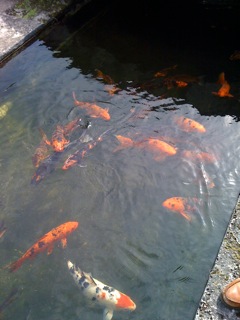 And have you ever been in a church or a cathedral and using a very
light palm pressure, touched the stones that make up the great walls?
If you haven't, why not check it out, just as you are? Find out for
yourself in your own experience, what this is, for you, if anything. And don't forget to bring along your
sense of humor in case anyone is watching!
And have you ever been in a church or a cathedral and using a very
light palm pressure, touched the stones that make up the great walls?
If you haven't, why not check it out, just as you are? Find out for
yourself in your own experience, what this is, for you, if anything. And don't forget to bring along your
sense of humor in case anyone is watching!
Couldn't help but think, "If these walls could talk"
As we walked out of the cathedral into the surrounding semi-tropical gardens, we would wonder how many here in this cathedral had ever given another person, even a child, or a well loved pet, the gift of a very light, high intentioned touch? Yes. A breeze lifted from the ocean, and we contemplated the intelligence, the Life that is beyond all stones, moats, cathedrals, mosques, ancient temples, even beyond the ocean, that infinite unnamable Source that animates All. Yes again Yes. Call it, Love. Yes. It was now time for me to take up Maxwell's silver and very invisible hammer, smash the stone of moat cathedral mosque crystal into fragments and to walk away.
James Nemec 2009
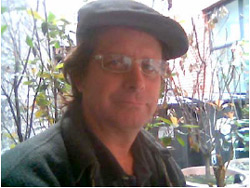 James
Nemec LMT, CST-D, grew up on the ocean in Palm Beach, Florida. He worked
as a performer and playwright and as a therapeutic facilitator in Craniosacral Therapy.
He was the founder of CraniOcean: Intuitive bodywork and massage in a blend with Craniosacral Therapy.
James
Nemec LMT, CST-D, grew up on the ocean in Palm Beach, Florida. He worked
as a performer and playwright and as a therapeutic facilitator in Craniosacral Therapy.
He was the founder of CraniOcean: Intuitive bodywork and massage in a blend with Craniosacral Therapy.
His books include Touch the Ocean: The Power of Our Collective Emotions, and Journeys: Stories Our Bodies Can Tell and Awake and Asleep.
James Nemec - Obituary
With heavy hearts, the Nemec Family announces that James Nemec, passed away on July 7, 2011 from a massive heart attack due to clogged arteries. If he had had a simple stress test he would be alive today. James was born in West Palm Beach on December 27, 1953. He was the only son of the late James and Ruth Nemec of Palm Beach. James was an amazing brother, incredible uncle, a fun cousin, and a good friend. He was a facilitator, teacher, healer, author, playwright, poet, artist and an actor.James attended Palm Beach High School, Forest Hill High School, and Graham Eckes before he graduated from The Gunnery in Connecticut. While attending Syracuse University, he spent a year in London as an exchange student, studying Theatre. He graduated from Stetson University in 1978 with a Bachelor of Arts and Humanities Degree. As a student in the Burt Reynolds Theatre Apprentice Program, Jim played the role of Happy in Death of a Salesman, where he worked with and became life long friends with Julie Harris and others in the entertainment industry. He moved to Los Angles and wrote Award-Winning plays for adults as well as children. Always a student of personal growth, James studied with Robert R. Gibson (Dr. Bob) where he developed his personal healing philosophy. This led to his passion to heal using CranioSacral Therapy, which he studied under John Upledger. In 1996 he received his LMT, CST; and in 1999, his DIPOLMATE certification from the Upledger Institute in Palm Beach Gardens.
James was celebrated for his ability to combine science and intuition to heal those previously considered beyond help. He worked with patients throughout the United States as well as internationally and founded CraniOcean Intuitive Body Work & Massage Therapy. A true Healer, he was able to touch the soul, the heart and the body. Growing up on the ocean in Palm Beach, James loved the sea and all it stood for. One of his favorite pastimes was to swim with the Dolphins. He used water work in his practice and many times worked with Dolphins to assist in the healing process. An Award-Winning author, James most recent works were written to expound on his theories and philosophy. Touch the Ocean: The Power Of Our Collective Emotions, won several awards; he narrated the audio book, on CD, just prior to his passing. He also wrote "Cranio-What?", a CranioSacral Primer for Dummies. His latest book, Journeys: The Stories Our Bodies Can Tell, was written to show how to receive the wisdom that arises from our own bodies.
References:
Knowth Virtual TourGenesis 6:4, King James Version
Idries Shah
James Joyce Museum - Joyce Tower in Sandycove
Rhondell - The Science of Man 48 Lessons : The Lamp of the Body
Roger Weir : Jesus in Alexandria
The Gospel of Mary Magdalene
Ulysses, by James Joyce
Boyne Valley Private Day Tour
 Immerse yourself in the rich heritage and culture of the Boyne Valley with our full-day private tours.
Visit Newgrange World Heritage site, explore the Hill of Slane, where Saint Patrick famously lit the Paschal fire.
Discover the Hill of Tara, the ancient seat of power for the High Kings of Ireland.
Book Now
Immerse yourself in the rich heritage and culture of the Boyne Valley with our full-day private tours.
Visit Newgrange World Heritage site, explore the Hill of Slane, where Saint Patrick famously lit the Paschal fire.
Discover the Hill of Tara, the ancient seat of power for the High Kings of Ireland.
Book Now
Home
| Newgrange
| Knowth
| Dowth
| Hill of Tara
| Fourknocks
| Loughcrew
| More Places
| Labyrinths
| Local Info
| Art Works
| Articles
| Images
| Books
| Links
| Boyne Valley Tours
| Contact

